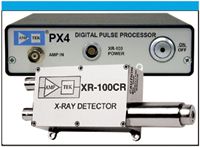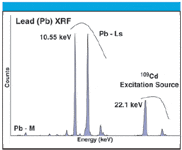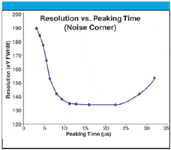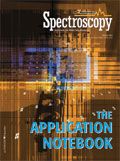A Powerful Tool for XRF and Detector Performance Characterization
Amptek, Inc.
The long anticipated PX4 Digital Pulse Processor from Amptek has joined the successful XR-100 family of X-ray detectors (as shown in Figure 1). The system allows for XRF analysis in the field and satisfies QC requirements for monitoring detector performance. The PX4 is also a powerful research tool that can be used to optimize detector performance.

As shown in Figure 2, the detection of lead (Pb) is an easy task for this pair of instruments. The L lines are easily resolved within 1 minute of unit power-on. Since the PX4 is driven by software, only one switch exists on the box (power). Everything else is software selectable and can be set to automatically load on startup. This ensures consistent, fast, and easy operation.

Figure 1. PX4 Digital Pulse Processor and XR-100CR X-ray Detector.
Since the PX4 has 24 programmable peaking times between 0.8 and 102 µs, it is well suited for a wide variety of applications. In addition, the determination of Resolution vs. Peaking Time (finding the noise corner), as in Figure 3, can be performed automatically by a software routine. With this information, the user can easily select the appropriate peaking time to maximize performance for the particular application, whether it be the best resolution, higher throughput, or a trade-off between the two.

Figure 2. Lead (Pb) Spectrum.
XRF measurements used to involve costly, liquid nitrogen dependent, instrumentation. Amptek has broken another barrier in offering a low cost, easy to use system that not only performs the measurements, but also characterizes the system to satisfy QC requirements and to optimize performance across a wide range of applications.

Figure 3. Resolution vs. Peaking Time.
Amptek, Inc.
6 De Angelo Drive, Bedford, MA 01730
Tel. (781) 275-2242, Fax (781) 275-3470

Thermo Fisher Scientists Highlight the Latest Advances in Process Monitoring with Raman Spectroscopy
April 1st 2025In this exclusive Spectroscopy interview, John Richmond and Tom Dearing of Thermo Fisher Scientific discuss the company’s Raman technology and the latest trends for process monitoring across various applications.
A Seamless Trace Elemental Analysis Prescription for Quality Pharmaceuticals
March 31st 2025Quality assurance and quality control (QA/QC) are essential in pharmaceutical manufacturing to ensure compliance with standards like United States Pharmacopoeia <232> and ICH Q3D, as well as FDA regulations. Reliable and user-friendly testing solutions help QA/QC labs deliver precise trace elemental analyses while meeting throughput demands and data security requirements.